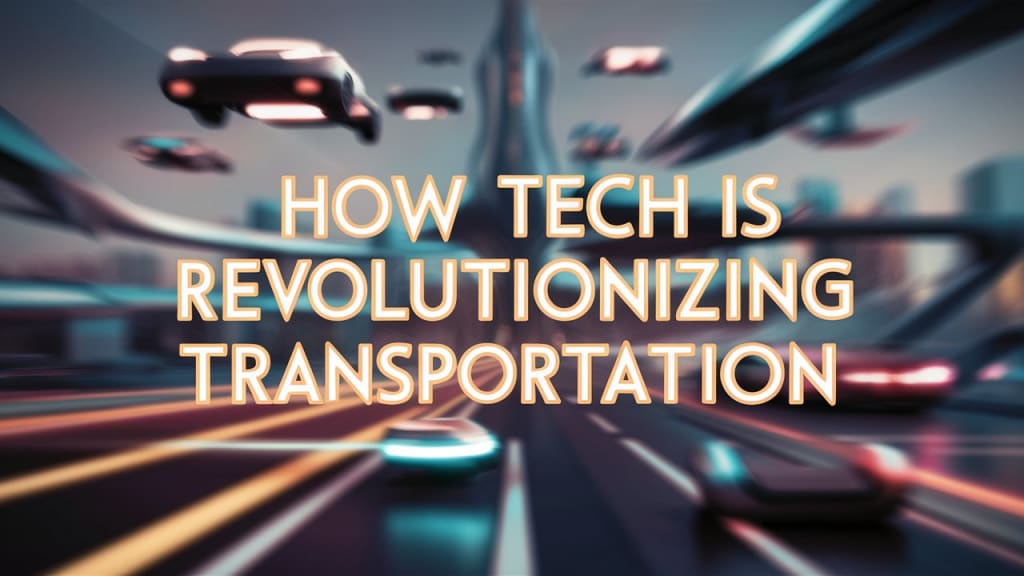How Tech is Revolutionizing Transportation: From Electric Cars to Hyperloop
Exploring the Cutting-Edge Innovations Changing the Way We Travel

Introduction
Transportation is undergoing a significant transformation, thanks to rapid advancements in technology. From electric cars to the futuristic Hyperloop, innovative solutions are reshaping how we move people and goods. These changes promise not only to make travel more efficient and convenient but also to address pressing environmental and societal challenges. In this article, we'll explore the latest technological advancements in transportation, how they're impacting our world, and what the future might hold.
Click Here to Boost Your Profits with High-Margin Products!
The Rise of Electric Cars
Electric cars are leading the charge in revolutionizing transportation. These vehicles, powered by electricity rather than traditional gasoline or diesel, offer numerous benefits, including reduced emissions and lower operating costs.
Benefits of Electric Cars
Environmental Impact: Electric cars produce zero tailpipe emissions, helping to reduce air pollution and combat climate change.
Cost Efficiency: With fewer moving parts and lower fuel costs, electric vehicles (EVs) are often cheaper to maintain and operate over their lifetime.
Performance: Modern electric cars offer impressive acceleration and smooth, quiet rides, providing a superior driving experience.
Popular Electric Car Models
Tesla Model 3: Known for its long range, advanced autopilot features, and sleek design.
Nissan Leaf: One of the most affordable and widely available electric cars, ideal for urban commuting.
Chevrolet Bolt EV: Offers a long driving range and spacious interior at a competitive price.
Challenges and Solutions
Despite their advantages, electric cars face several challenges, including limited driving range, long charging times, and high upfront costs.
Solutions:
Battery Technology: Advances in battery technology are increasing the range and reducing the cost of electric cars. New solid-state batteries promise even greater improvements.
Charging Infrastructure: Expanding the network of fast-charging stations makes it easier for drivers to recharge their vehicles quickly and conveniently.
Incentives and Subsidies: Government incentives and subsidies can help offset the higher initial cost of electric cars, making them more accessible to consumers.
Autonomous Vehicles: The Future of Driving
Autonomous vehicles (AVs), also known as self-driving cars, represent another major technological breakthrough in transportation. These vehicles use advanced sensors, cameras, and AI to navigate roads and make driving decisions without human intervention.
Levels of Autonomy
Autonomous vehicles are classified into five levels, ranging from Level 1 (driver assistance) to Level 5 (full autonomy).
Key Features of Autonomous Vehicles:
Level 1: Basic driver assistance, such as adaptive cruise control and lane-keeping assist.
Level 2: Partial automation, where the vehicle can control both steering and acceleration/deceleration, but the driver must remain engaged.
Level 3: Conditional automation, allowing the vehicle to handle most driving tasks, with the driver ready to take over when needed.
Level 4: High automation, where the vehicle can operate independently in certain conditions, without driver intervention.
Level 5: Full automation, enabling the vehicle to drive itself in all conditions without any human input.
Advantages of Autonomous Vehicles
Safety: Autonomous vehicles have the potential to reduce accidents caused by human error, such as distracted driving or impaired driving.
Efficiency: Self-driving cars can optimize routes and reduce traffic congestion, leading to more efficient travel.
Accessibility: AVs can provide mobility solutions for individuals who cannot drive, such as the elderly or disabled.
Challenges and Solutions
The development and deployment of autonomous vehicles face several hurdles, including technological limitations, regulatory challenges, and public acceptance.
Solutions:
Technological Advancements: Continued research and development in AI, machine learning, and sensor technology are crucial for improving the reliability and safety of AVs.
Regulatory Frameworks: Governments need to establish clear regulations and standards for the testing and deployment of autonomous vehicles.
Public Education: Increasing public awareness and understanding of the benefits and safety of AVs can help build trust and acceptance.
Click Here to Boost Your Profits with High-Margin Products!
Hyperloop: The Future of High-Speed Travel
Hyperloop is a futuristic transportation concept that aims to revolutionize long-distance travel by using pods traveling through low-pressure tubes at extremely high speeds.
How Hyperloop Works
Magnetic Levitation: Hyperloop pods use magnetic levitation (maglev) technology to float above the tracks, reducing friction and allowing for smooth, high-speed travel.
Low-Pressure Tubes: The tubes are maintained at low pressure to minimize air resistance, enabling pods to travel at speeds of up to 760 mph (1,220 km/h).
Electric Propulsion: Electric motors provide the propulsion needed to accelerate and decelerate the pods.
Advantages of Hyperloop
Speed: Hyperloop can significantly reduce travel times between cities, making it a faster alternative to air travel for certain distances.
Energy Efficiency: The system is designed to be highly energy-efficient, potentially using renewable energy sources for propulsion.
Capacity: Hyperloop can transport large numbers of passengers and cargo, easing congestion on existing transportation networks.
Challenges and Solutions
Hyperloop faces significant technical, financial, and regulatory challenges that must be addressed before it can become a reality.
Solutions:
Technological Innovation: Ongoing research and development are essential for overcoming technical challenges, such as maintaining low-pressure environments and ensuring safety.
Investment and Funding: Public and private investment can support the development and deployment of Hyperloop systems, helping to bring the concept to market.
Regulatory Approval: Governments need to develop regulatory frameworks that ensure the safety and feasibility of Hyperloop operations.
Drones: Transforming Delivery and Transportation
Drones, or unmanned aerial vehicles (UAVs), are revolutionizing delivery services and transportation logistics. These flying devices can transport goods quickly and efficiently, bypassing traditional road networks.
Applications of Drones in Transportation
Package Delivery: Companies like Amazon and UPS are exploring drone delivery services to speed up the delivery of packages, especially in urban areas.
Medical Supplies: Drones can deliver medical supplies and emergency aid to remote or hard-to-reach locations, improving healthcare access.
Traffic Monitoring: Drones equipped with cameras and sensors can monitor traffic conditions and provide real-time data to optimize traffic management.
Advantages of Drone Delivery
Speed: Drones can deliver goods faster than traditional delivery methods, reducing delivery times.
Cost-Effectiveness: Drones can lower delivery costs by reducing the need for human drivers and vehicles.
Environmental Impact: Drones produce fewer emissions compared to traditional delivery vehicles, contributing to environmental sustainability.
Challenges and Solutions
Drone delivery faces several obstacles, including regulatory restrictions, safety concerns, and technological limitations.
Solutions:
Regulatory Frameworks: Governments need to establish regulations that ensure the safe and efficient use of drones for delivery and transportation.
Technological Advancements: Continued innovation in drone technology, such as improved battery life and navigation systems, is essential for expanding their capabilities.
Public Acceptance: Educating the public about the benefits and safety of drone delivery can help build acceptance and trust in the technology.
The Future of Public Transportation
Technology is also transforming public transportation, making it more efficient, sustainable, and user-friendly.
Electric Buses
Electric buses are becoming increasingly popular as cities look to reduce emissions and improve air quality. These buses are powered by electricity, offering a cleaner alternative to traditional diesel buses.
Benefits of Electric Buses:
Environmental Impact: Electric buses produce zero emissions, helping to reduce air pollution in urban areas.
Cost Savings: Lower fuel and maintenance costs make electric buses a cost-effective option for public transportation systems.
Passenger Experience: Electric buses offer a smoother and quieter ride, enhancing the passenger experience.
Smart Public Transit Systems
Smart public transit systems use technology to optimize routes, improve service reliability, and enhance the overall user experience.
Key Features of Smart Transit Systems:
Real-Time Tracking: GPS and mobile apps allow passengers to track buses and trains in real-time, reducing wait times and improving convenience.
Contactless Payments: Smart card systems and mobile payment apps make it easier for passengers to pay for fares without cash.
Data-Driven Planning: Analyzing ridership data helps transit authorities optimize routes and schedules to better meet passenger needs.
Click Here to Boost Your Profits with High-Margin Products!
Conclusion
Technology is revolutionizing transportation in numerous ways, from electric cars and autonomous vehicles to futuristic concepts like Hyperloop and drones. These innovations promise to make travel faster, safer, and more sustainable, while also addressing critical challenges such as traffic congestion, pollution, and accessibility. As we continue to embrace these technological advancements, it's essential to address the associated challenges and ensure that the benefits of modern transportation are accessible to all. The future of transportation is bright, and with ongoing innovation and collaboration, we can look forward to a more connected and efficient world.
About the Creator
Enjoyed the story? Support the Creator.
Subscribe for free to receive all their stories in your feed. You could also pledge your support or give them a one-off tip, letting them know you appreciate their work.






Comments
There are no comments for this story
Be the first to respond and start the conversation.